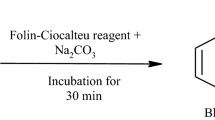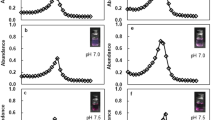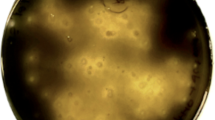Abstract
R-2-(4-Hydroxyphenoxy)propionic acid (R-HPPA) is a pivotal intermediate for the synthesis of aryloxyphenoxypropionate (APP) herbicide. To rapidly screen microbial isolates with the capacity of hydroxylating R-2-phenoxypropionic acid to R-HPPA from various environmental samples, a convenient and safe 96-well microplate assay method with sodium nitrite (NaNO2) as chromogenic reagent was proposed and optimized. The optimum assay conditions were as follows: the detection wavelength was 420 nm, the concentration of NaNO2 solution was 6.0 g/L, color reaction temperature was 60 °C, the pH of the NaNO2 solution was 2.4, and the reaction time was 40 min. With the aid of this method, screening for microorganisms with C-4-specific hydroxylation activity of R-PPA was conducted. As a result, 23 strains among 3744 single colonies isolated from various samples exhibited the hydroxylation activity. Among these strains, the highest bioconversion rate was achieved by Penicillium oxalicum A5 and Aspergillus versicolor A12, respectively. After 72-h cultivation in shake flask, their conversion rates of R-HPPA from 10 g/L R-PPA reached 21.18% and 40.24%, respectively. The established method was effective in rapid screening of microbes capable of biosynthesizing R-HPPA through hydroxylation of R-PPA, and the obtained two fungi species could be potentially used for R-HPPA production.








Similar content being viewed by others
References
Cruz-Hipolito, H., Osuna, M. D., Dominguez-Valenzuela, J. A., Espinoza, N., & De Prado, R. (2011). Mechanism of resistance to ACCase-inhibiting herbicides in wild oat (Avena fatua) from Latin America. Journal of Agricultural and Food Chemistry, 59(13), 7261–7267. https://doi.org/10.1021/jf201074k.
Brown, R. B., Kruse, J. A., Counts, G. W., Russell, J. A., Christou, N. V., & Sands, M. L. (1990). Double-blind study of endotracheal tobramycin in the treatment of gram-negative bacterial pneumonia. Antimicrobial Agents and Chemotherapy, 34(2), 269–272. https://doi.org/10.1128/aac.34.2.269.
Zheng, J.-Y., Wu, J.-Y., Zhang, Y.-J., & Wang, Z. (2013). Resolution of (R, S)-ethyl-2-(4-hydroxyphenoxy) propanoate using lyophilized mycelium of Aspergillus oryzae WZ007. Journal of Molecular Catalysis B: Enzymatic, 97, 62–66. https://doi.org/10.1016/j.molcatb.2013.07.016.
Tajik, H., Dadras, A., & Aghabeygi, S. (2011). A facile synthesis of novel optically active R,R-2-(4-(2-(4-(5-chloro-3-halo-pyridin-2-yloxy)-phenoxy)-propionyloxy)-phenoxy)-propionic acid esters using cyanuric chloride as potential herbicide. Chinese Chemical Letters, 22(5), 535–538. https://doi.org/10.1016/j.cclet.2010.12.001.
Cleugh, E. (2007). Production process of optically pure 2-(4-hydroxyphenoxy)-propionic acid compounds. European Patent 1670743B1, 2007-02-14.
Fleer, M., & Verkuijl, B. (2014). Optimization of the use of a chiral bio-based building block for the manufacture of DHPPA, a key intermediate for propionate herbicides. Green Chemistry, 16(8), 3993–3998. https://doi.org/10.1039/C4GC00797B.
Dingler, C., Ladner, W., Krei, G. A., Cooper, B., & Hauer, B. (1996). Preparation of (R)-2-(4-hydroxyphenoxy) propionic acid by biotransformation. Pesticide Science, 46(1), 33–35. https://doi.org/10.1002/(sici)1096-9063(199601)46:1<33::aid-ps338>3.0.co;2-r.
Dingler, C., Ladner, W., & Krei, G. (1995). Process for the biotransformation of carboxylic acids in the presence of a microorganism. Canada Patent CA2188834(A1), 1995-11-02.
Hu, H. F., Zhou, H. Y., Wang, M. X., Wang, Y. S., Xue, Y. P., & Zheng, Y. G. (2019). A rapid throughput assay for screening (R)-2-(4-hydroxyphenoxy)propionic acid producing microbes. Journal of Microbiological Methods, 158, 44–51. https://doi.org/10.1016/j.mimet.2019.01.015.
Facey, S. J., Nebel, B. A., Kontny, L., Allgaier, M., & Hauer, B. (2018). Rapid and complete degradation of diclofenac by native soil microorganisms. Environmental Technology and Innovation, 10, 55–61. https://doi.org/10.1016/j.eti.2017.12.009.
Semba, H., Mukouyama, M., & Sakano, K. (1996). A para-site-specific hydroxylation of various aromatic compounds by Mycobacterium sp. strain 12523. Applied Microbiology and Biotechnology, 46(4), 432–437. https://doi.org/10.1007/bf00166241.
Sun, J., Pan, L., & Zhu, L. (2018). Formation of hydroxylated and methoxylated polychlorinated biphenyls by Bacillus subtilis: new insights into microbial metabolism. Science of The Total Environment, 613–614, 54–61. https://doi.org/10.1016/j.scitotenv.2017.09.063.
Yamada, M., Yoshida, T., & Nagasawa, T. (2009). Microbial conversion of 5-sulfoisophthalic acid into 5-hydroxyisophthalic acid by Ochrobactrum anthropi S9. Biotechnology Letters, 32(3), 445–450. https://doi.org/10.1007/s10529-009-0171-6.
Zawadzka, K., Bernat, P., Felczak, A., & Lisowska, K. (2015). Carbazole hydroxylation by the filamentous fungi of the Cunninghamella species. Environmental Science and Pollution Research International, 22(24), 19658–19666. https://doi.org/10.1007/s11356-015-5146-7.
Xu, J. M., Fu, F. T., Hu, H. F., & Zheng, Y. G. (2016). A high-throughput screening method for amino acid dehydrogenase. Analytical Biochemistry, 495, 29–31. https://doi.org/10.1016/j.ab.2015.11.012.
Zhu, X., Arman, B., Chu, J., Wang, Y., & Zhuang, Y. (2017). Development of a method for efficient cost-effective screening of Aspergillus niger mutants having increased production of glucoamylase. Biotechnology Letters, 39(5), 739–744. https://doi.org/10.1007/s10529-017-2291-8.
Kosa, G., Zimmermann, B., Kohler, A., Ekeberg, D., Afseth, N. K., Mounier, J., & Shapaval, V. (2018). High-throughput screening of Mucoromycota fungi for production of low- and high-value lipids. Biotechnology for Biofuels, 11(1), 66. https://doi.org/10.1186/s13068-018-1070-7.
Kang, X.-M., Zhang, X.-J., Hong, L.-L., Peng, F., Liu, Z.-Q., & Zheng, Y.-G. (2019). Establishment of a novel high-throughput screening method for the detection and quantification of L-phosphinothricin produced by a biosynthesis approach. Process Biochemistry, 76, 136–141. https://doi.org/10.1016/j.procbio.2018.10.015.
Zhou, H. Y., Li, Y. Z., Jiang, R., Hu, H. F., Wang, Y. S., Liu, Z. Q., Xue, Y. P., & Zheng, Y. G. (2019). A high-throughput screening method for improved R-2-(4-hydroxyphenoxy)propionic acid biosynthesis. Bioprocess and Biosystems Engineering, 42(10), 1573–1582. https://doi.org/10.1007/s00449-019-02154-1.
Patnaik, P., & Khoury, J. N. (2004). Reaction of phenol with nitrite ion: pathways of formation of nitrophenols in environmental waters. Water Research, 38(1), 206–210. https://doi.org/10.1016/j.watres.2003.08.022.
Preeti, R., Pandey, A., & Binod, P. (2017). Microbial production of ketoreductases: development of a novel high-throughput screening method. Bioresource Technology, 242, 319–323. https://doi.org/10.1016/j.biortech.2017.03.096.
Pinto, F. C. J., de Lima, D. B., Agustini, B. C., Dallagassa, C. B., Shimabukuro, M. F., Chimelli, M., Brand, D., Fadel-Picheth, C. M. T., & Bonfim, T. M. B. (2012). Morphological and molecular identification of filamentous fungi isolated from cosmetic powders. Brazilian Archives of Biology and Technology, 55, 897–901. https://doi.org/10.1590/S1516-89132012000600013.
Iheanacho, H. E., Njobeh, P. B., Dutton, F. M., Steenkamp, P. A., Steenkamp, L., Mthombeni, J. Q., Daru, B. H., & Makun, A. H. (2014). Morphological and molecular identification of filamentous Aspergillus flavus and Aspergillus parasiticus isolated from compound feeds in South Africa. Food Microbiology, 44, 180–184. https://doi.org/10.1016/j.fm.2014.05.019.
Kavitha, S., Khambhaty, Y., & Chandra Babu, N. K. (2018). Evaluation of industrial biocides on a novel Aspergillus versicolor TANCK-1 and elucidation of their probable biocidal mechanism. Indian Journal of Microbiology, 58(1), 51–59. https://doi.org/10.1007/s12088-017-0696-7.
Huh, H. J., Lee, J. H., Park, K. S., Jun, T.-G., Kang, I. S., Kim, Y.-J., Ki, C.-S., & Lee, N. Y. (2013). A case of misidentification of Aspergillus versicolor complex as Scopulariopsis species isolated from a homograft. Annals of Clinical Microbiology, 16(2), 105–109. https://doi.org/10.5145/ACM.2013.16.2.105.
Jarvis, W. R., Barrie, S. D., Traquair, J. A., & Stoessl, A. (1990). Morphological and chemical studies of Penicillium oxalicum, newly identified as a pathogen on greenhouse cucumbers. Canadian Journal of Botany, 68(1), 21–25. https://doi.org/10.1139/b90-003.
Khokhar, I., Mukhtar, I., & Mushtaq, S. (2011). Isolation and screening of amylolytic filamentous fungi. Journal of Applied Sciences and Environmental Management, 15(1), 203–206. https://doi.org/10.4314/jasem.v15i1.68442.
Papagianni, M. (2014). An evaluation of the proteolytic and lipolytic potential of Penicillium spp. isolated from traditional Greek sausages in submerged fermentation. Applied Biochemistry and Biotechnology, 172(2), 767–775. https://doi.org/10.1007/s12010-013-0570-y.
Liao, H., Li, S., Wei, Z., Shen, Q., & Xu, Y. (2014). Insights into high-efficiency lignocellulolytic enzyme production by Penicillium oxalicum GZ-2 induced by a complex substrate. Biotechnology for Biofuels, 7(1), 162. https://doi.org/10.1186/s13068-014-0162-2.
Haggag, W. M., & Soud, M. A. E. (2013). Pilot-scale production and optimizing of cellulolytic Penicillium oxalicum for controlling of mango malformation. Agricultural Sciences, 4(4), 165–174. https://doi.org/10.4236/as.2013.44024.
Liao, H., Zheng, H., Li, S., Wei, Z., Mei, X., Ma, H., Shen, Q., & Xu, Y. (2015). Functional diversity and properties of multiple xylanases from Penicillium oxalicum GZ-2. Scientific Reports, 5, 12631. https://doi.org/10.1038/srep12631.
Hu, Y., Xue, H., Liu, G., Song, X., & Qu, Y. (2015). Efficient production and evaluation of lignocellulolytic enzymes using a constitutive protein expression system in Penicillium oxalicum. Journal of Industrial Microbiology & Biotechnology, 42(6), 877–887. https://doi.org/10.1007/s10295-015-1607-8.
Saroj, S., Dubey, S., Agarwal, P., Prasad, R., & Singh, R. P. (2015). Evaluation of the efficacy of a fungal consortium for degradation of azo dyes and simulated textile dye effluents. Sustainable Water Resources Management, 1(3), 233–243. https://doi.org/10.1007/s40899-015-0027-2.
Saroj, S., Kumar, K., Prasad, M., & Singh, R. P. (2014). Differential expression of peroxidase and ABC transporter as the key regulatory components for degradation of azo dyes by Penicillium oxalicum SAR-3. Functional & Integrative Genomics, 14(4), 631–642. https://doi.org/10.1007/s10142-014-0405-0.
Zehra, A., Dubey, M. K., Meena, M., Aamir, M., Patel, C. B., & Upadhyay, R. S., Chapter 14 - Role of Penicillium species in bioremediation processes, in New and Future Developments in Microbial Biotechnology and Bioengineering, Gupta, V. K., & Rodriguez-Couto, S., Editors. 2018, Elsevier: Amsterdam. 247–260.
Kinne, M., Ullrich, R., Hammel, K. E., Scheibner, K., & Hofrichter, M. (2008). Regioselective preparation of (R)-2-(4-hydroxyphenoxy)propionic acid with a fungal peroxygenase. Tetrahedron Letters, 49(41), 5950–5953. https://doi.org/10.1016/j.tetlet.2008.07.152.
Yarman, A., Badalyan, A., Gajovic-Eichelmann, N., Wollenberger, U., & Scheller, F. W. (2011). Enzyme electrode for aromatic compounds exploiting the catalytic activities of microperoxidase-11. Biosensors & Bioelectronics, 30(1), 320–323. https://doi.org/10.1016/j.bios.2011.09.004.
Kluge, M., Ullrich, R., Dolge, C., Scheibner, K., & Hofrichter, M. (2009). Hydroxylation of naphthalene by aromatic peroxygenase from Agrocybe aegerita proceeds via oxygen transfer from H2O2 and intermediary epoxidation. Applied Microbiology and Biotechnology, 81(6), 1071–1076. https://doi.org/10.1007/s00253-008-1704-y.
Peng, L., Wollenberger, U., Kinne, M., Hofrichter, M., Ullrich, R., Scheibner, K., Fischer, A., & Scheller, F. W. (2010). Peroxygenase based sensor for aromatic compounds. Biosensors & Bioelectronics, 26(4), 1432–1436. https://doi.org/10.1016/j.bios.2010.07.075.
Funding
The authors gratefully acknowledge the financial support of the National Natural Science Foundation of China (No. 31500031) and the Natural Science Foundation of Zhejiang Province (No. LQ14B060004).
Author information
Authors and Affiliations
Corresponding author
Ethics declarations
Conflict of Interest
The authors declare that they have no conflict of interest.
Additional information
Publisher’s Note
Springer Nature remains neutral with regard to jurisdictional claims in published maps and institutional affiliations.
Electronic Supplementary Material
ESM 1
(DOCX 126 kb)
Rights and permissions
About this article
Cite this article
Zhou, HY., Jiang, R., Li, YZ. et al. Screening of Fungi Isolates for C-4 Hydroxylation of R-2-Phenoxypropionic Acid Based on a Novel 96-Well Microplate Assay Method. Appl Biochem Biotechnol 192, 42–56 (2020). https://doi.org/10.1007/s12010-020-03303-z
Received:
Accepted:
Published:
Issue Date:
DOI: https://doi.org/10.1007/s12010-020-03303-z




